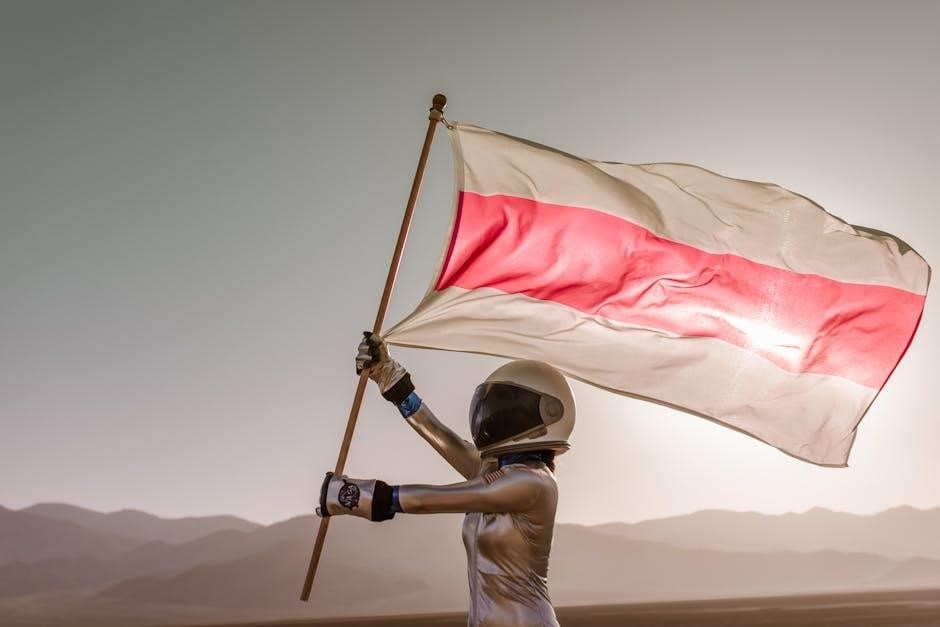Humanity’s journey is marked by remarkable achievements, showcasing ingenuity, resilience, and creativity. This guide explores technological, scientific, and cultural milestones, celebrating progress and inspiring future generations.
1.1. Understanding Human Ingenuity and Progress
Human ingenuity and progress are the driving forces behind the remarkable advancements that have shaped civilization. From harnessing fire to exploring space, these achievements reflect humanity’s innate curiosity and problem-solving abilities. Ingenuity, often born out of necessity, has led to groundbreaking innovations that transformed societies, while progress underscores the continuous pursuit of improvement. This interplay of creativity and determination has enabled humans to overcome challenges, adapt to environments, and push boundaries. Understanding these elements provides insight into how humanity has evolved and continues to strive for a better future, inspiring generations to embrace innovation and build upon past successes.
1.2. The Significance of Documenting Achievements
Documenting humanity’s achievements is a cornerstone of progress, preserving history and inspiring future generations. By recording milestones, we honor the efforts of visionaries and innovators, ensuring their legacy endures. This documentation serves as a repository of knowledge, enabling societies to learn from past successes and challenges. It fosters a sense of unity, highlighting collective efforts that have shaped the world. Moreover, it motivates individuals to pursue greatness, knowing their contributions could inspire others. Documenting achievements also promotes accountability and transparency, while celebrating the diversity of human ingenuity. Ultimately, it ensures that the journey of progress is never forgotten, guiding humanity toward a brighter future.

Historical Milestones in Human Achievement
From mastering fire to developing agriculture and inventing the wheel, these milestones mark humanity’s early strides toward progress, laying the foundation for civilizations and advancements.
2.1. Mastery of Fire
Mastering fire was one of humanity’s earliest and most transformative achievements, providing warmth, enabling food cooking, and facilitating metalworking. This innovation marked a pivotal shift in human development, enhancing survival and societal progress. By controlling fire, early humans could adapt to various climates, preserve food, and create tools, laying the groundwork for civilizations. It symbolizes humanity’s ingenuity and adaptability, setting the stage for future advancements across industries and cultures.
2.2. Development of Agriculture
The development of agriculture ranks among humanity’s most impactful achievements, transitioning societies from nomadic hunting-gathering to structured farming communities. This shift enabled population growth, specialized labor, and the rise of civilizations. Agriculture introduced crop domestication, tools, and irrigation systems, ensuring food security and economic stability. It laid the foundation for cultural advancements, urbanization, and technological progress, reshaping human life and fostering societal complexity. The ability to cultivate and manage food resources remains a cornerstone of modern society, highlighting agriculture’s enduring significance in human history.
2.3. Invention of the Wheel
The invention of the wheel, circa 4000-3500 BCE, revolutionized human society, marking a pivotal leap in technology and productivity. It transformed transportation, enabling efficient movement of goods and people, while also advancing agriculture and trade. The wheel’s concept extended to machinery, powering mills and gears, and became a cornerstone of the Industrial Revolution. Its impact on human progress is immeasurable, showcasing the power of innovation to reshape daily life and foster global connectivity, making it one of humanity’s most enduring and transformative achievements.

Technological Advancements
Technological advancements have reshaped human history, driving innovation and improving quality of life. From the printing press to the internet and quantum physics, these breakthroughs have fueled global progress.
3.1. The Printing Press
The printing press, invented by Johannes Gutenberg in the 15th century, revolutionized communication and knowledge dissemination. It enabled mass production of books, democratizing education and facilitating the spread of ideas during the Renaissance and beyond. This innovation played a pivotal role in reducing the time and cost of producing written materials, making literature and information accessible to a wider audience. By standardizing written content, the printing press also promoted consistency in language and literacy, laying the foundation for modern publishing and education systems. Its impact remains profound, marking a cornerstone of human technological and intellectual progress.
3.2. The Internet Revolution
The Internet Revolution transformed global communication, enabling instant connectivity and information sharing. It emerged in the late 20th century, revolutionizing how people interact, work, and access knowledge. By breaking geographical barriers, it fostered global collaboration and innovation. The Internet democratized access to information, empowering individuals and organizations alike. It reshaped industries, from education to entertainment, and gave rise to e-commerce and digital media. Despite challenges like privacy concerns and misinformation, the Internet remains a cornerstone of modern life, driving progress and connecting billions worldwide. Its impact on humanity is unparalleled, making it one of the most significant technological advancements in history.
3.3. The Invention of the Computer Chip
The invention of the computer chip in the 20th century revolutionized technology, enabling compact and efficient processing power. Silicon-based chips replaced bulky vacuum tubes, leading to smaller, faster, and more reliable devices. This innovation was crucial for personal computers, smartphones, and modern computing. The chip’s impact extended to medicine, aerospace, and communication, driving technological advancements. Its development symbolizes human ingenuity and collaboration, transforming how we live, work, and connect. The computer chip remains a cornerstone of the digital age, testament to humanity’s ability to innovate and adapt, paving the way for future technological breakthroughs and societal progress.

Scientific Discoveries
Scientific breakthroughs have reshaped humanity’s understanding of the universe, from disease eradication to space exploration, showcasing our relentless pursuit of knowledge and innovation for the betterment of life.
4.1. Vaccination and Disease Eradication
Vaccination stands as one of humanity’s most profound scientific achievements, saving millions of lives and eradicating diseases like smallpox. The development of vaccines has revolutionized public health, significantly reducing mortality rates and preventing the spread of infectious diseases. For instance, the smallpox vaccine eliminated a disease that once plagued humanity for centuries. Similarly, vaccines for polio, measles, and tetanus have had a transformative impact globally. According to UNICEF, vaccines save six lives every minute, highlighting their critical role in global health. These advancements underscore humanity’s commitment to safeguarding life and improving quality of living, making vaccination a cornerstone of modern medicine and a testament to scientific ingenuity.
4.2. Space Exploration
Space exploration represents a monumental leap in human achievement, driven by curiosity and innovation. The Apollo 11 moon landing in 1969 marked a historic milestone, with Neil Armstrong’s iconic words echoing humanity’s ambition. The launch of Sputnik in 1957 and subsequent Mars rovers have expanded our understanding of the cosmos. Missions like the Hubble Space Telescope have unveiled celestial wonders, while the International Space Station exemplifies global collaboration. These endeavors have not only advanced scientific knowledge but also inspired generations, symbolizing humanity’s relentless pursuit of discovery and its boundless potential to explore the unknown, fostering hope for future interstellar achievements and unraveling the universe’s mysteries.
4.3. Quantum Physics Breakthroughs
Quantum physics breakthroughs have revolutionized our understanding of the universe, revealing the intricate dance of particles at the atomic and subatomic levels. The discovery of the Higgs boson in 2012, facilitated by the Large Hadron Collider, confirmed the Standard Model of particle physics, a landmark in human scientific endeavor. Advances in quantum computing promise to solve complex problems previously unimaginable, driving innovation in fields from cryptography to medicine. These achievements underscore humanity’s curiosity and ingenuity, pushing the boundaries of knowledge and paving the way for future technological marvels.

Cultural and Artistic Achievements
Cultural and artistic achievements reflect humanity’s creative genius, from masterpieces like the Mona Lisa to Shakespeare’s timeless literature, enriching global heritage and inspiring future generations.
5.1. Leonardo da Vinci’s Mona Lisa
The Mona Lisa, painted by Leonardo da Vinci in the early 16th century, is one of the most iconic works of art in human history. Its enigmatic smile and masterful use of sfumato technique have captivated art lovers for centuries. This painting exemplifies Renaissance art’s pinnacle, blending realism and emotion. The Mona Lisa’s enduring popularity highlights humanity’s ability to create timeless beauty and intellectual depth through art. It remains a symbol of cultural excellence and continues to inspire artists and enthusiasts worldwide, showcasing the profound impact of individual creativity on global heritage.
5.2. William Shakespeare’s Literary Works
William Shakespeare’s literary works are a cornerstone of human cultural achievement, shaping literature and theater for centuries. His plays and poems, such as Romeo and Juliet, Hamlet, and Macbeth, explore universal themes of love, power, and mortality. Shakespeare’s mastery of language, complex characters, and emotional depth has influenced countless writers and artists. His works remain widely performed and studied, reflecting humanity’s enduring capacity for storytelling and emotional expression. Shakespeare’s legacy is a testament to the power of art to transcend time and connect people across cultures, solidifying his role as one of history’s greatest literary figures.
5.3. Michelangelo’s Sculptures
Michelangelo’s sculptures represent the pinnacle of artistic excellence, embodying the Renaissance ideal of human potential. His iconic works, such as the statue of David and the Pietà, showcase unparalleled mastery of marble. Michelangelo’s ability to extract beauty and emotion from raw stone has inspired generations, defining the standard for sculpture. His art reflects a deep understanding of anatomy and a profound sense of spirituality, creating timeless pieces that continue to awe and inspire. As a cultural treasure, Michelangelo’s sculptures stand as a testament to humanity’s creative genius and enduring influence on the world of art.

Architectural Marvels
Architectural marvels like the Great Pyramid, Taj Mahal, and Colosseum epitomize human ingenuity, blending artistry with engineering. These structures stand as timeless symbols of cultural and historical significance.
6.1. The Great Pyramid of Giza
The Great Pyramid of Giza, constructed around 2580 BC, is the oldest and most impressive architectural marvel of ancient civilization. This monumental structure, originally 146.6 meters tall, was built as a tomb for Pharaoh Khufu. Its precise alignment with true north and the sophistication of its construction highlight human engineering ingenuity. The pyramid’s base, covering 13 acres, was crafted with over 2.3 million stone blocks, each weighing an average of 2.5 tons. This feat of ancient engineering remains a testament to human creativity and perseverance, standing as the only remaining structure of the Seven Wonders of the Ancient World.
6.2. The Taj Mahal
The Taj Mahal, a breathtaking white marble mausoleum in Agra, India, was built by Emperor Shah Jahan in memory of his wife, Mumtaz Mahal, between 1632 and 1648. This architectural masterpiece combines Persian, Ottoman, and Indian styles, featuring intricate inlays of precious stones and calligraphy. Its perfect proportions and symmetrical design reflect the pinnacle of Mughal craftsmanship. The Taj Mahal attracts millions annually, symbolizing eternal love and cultural richness. A UNESCO World Heritage site, it stands as a testament to human artistic and engineering prowess, blending beauty with historical significance in a way that transcends time and inspires global admiration.
6.3. The Colosseum
The Colosseum, an iconic amphitheater in Rome, Italy, stands as a monumental achievement of ancient Roman engineering and architecture. Constructed between 70-80 AD under Emperor Vespasian, it could hold up to 80,000 spectators for gladiatorial contests, animal hunts, and public events. Its elliptical design and advanced drainage system showcased Roman ingenuity. The Colosseum symbolized Roman power and cultural influence, hosting events that unified society; Despite centuries of damage, it remains a UNESCO World Heritage site, inspiring awe and historical reflection. Its legacy endures as a testament to human creativity and the enduring impact of ancient civilizations on modern culture.

Social and Humanitarian Progress
Society has achieved milestones in unity, equality, and justice, reducing disparities and fostering human rights, creating a more inclusive and compassionate global community over time.
7.1. The Fall of the Berlin Wall
The fall of the Berlin Wall in 1989 marked a historic moment of unity and freedom, symbolizing the end of division between East and West. This event, occurring on November 9, 1989, was a pivotal milestone in modern history, leading to Germany’s reunification and the dismantling of the Iron Curtain. It represented the triumph of democracy over oppression, enabling free movement and reuniting families. The Wall’s collapse was a powerful symbol of humanity’s quest for liberty and equality, inspiring global movements for human rights and freedom, leaving a lasting legacy of hope and resilience in the face of adversity.
7.2. The Abolition of Slavery
The abolition of slavery stands as a monumental achievement in humanity’s pursuit of equality and justice. It was the culmination of relentless efforts by reformers, activists, and governments to end centuries of oppression. The movement highlighted the power of moral conviction and collective action, leading to the liberation of millions. By dismantling systems of exploitation, it laid the foundation for modern human rights frameworks. The abolition of slavery not only freed individuals but also reshaped societal values, fostering a global commitment to dignity and freedom. This triumph underscores humanity’s capacity to overcome injustice and strive for a more equitable world.
7.3. The Universal Declaration of Human Rights
The Universal Declaration of Human Rights (UDHR), adopted in 1948, is a landmark achievement in humanity’s pursuit of justice and equality. It established a shared global standard for fundamental human rights, emphasizing dignity, freedom, and equality for all. Drafted in the aftermath of World War II, the UDHR addressed the urgent need to prevent future atrocities by outlining 30 articles that safeguard civil, political, economic, and social rights. Its principles have shaped international law and inspired countless human rights movements worldwide. The UDHR remains a cornerstone of global justice, affirming that human rights are universal, inalienable, and essential for peace and prosperity.

Environmental Conservation
Humanity’s commitment to environmental conservation shines through reforestation, coral reef recovery, and wildlife preservation. These efforts protect ecosystems, ensuring a sustainable future for all life on Earth.
8.1. Reforestation Efforts
Reforestation efforts have emerged as a cornerstone of humanity’s commitment to environmental restoration. Through dedicated initiatives, millions of trees have been planted worldwide, revitalizing ecosystems and combating deforestation. Individuals like Jadav Payeng have inspired global movements, transforming barren landscapes into thriving forests. These efforts not only combat climate change by absorbing carbon dioxide but also preserve biodiversity and support local communities. Reforestation underscores humanity’s capacity for collective action and sustainable stewardship, ensuring a greener legacy for future generations. Such achievements highlight the profound impact of individual and collective efforts in healing the planet and fostering ecological balance.
8.2. Coral Reef Recovery
Coral reef recovery initiatives represent a significant triumph in marine conservation. Recent improvements in reefs, such as in the Great Barrier Reef and off Tanzania, highlight effective management strategies. Better fisheries regulation and community involvement have spurred coral regeneration, protecting biodiversity and coastal economies. These efforts demonstrate humanity’s ability to address environmental challenges through collaboration and sustainable practices. Coral reefs, vital for marine ecosystems, are now benefiting from targeted conservation, offering hope for their survival. Such achievements underscore the importance of preserving oceanic health and the positive impact of concerted global efforts in environmental restoration.
8.3. Wildlife Preservation
Wildlife preservation stands as a testament to humanity’s commitment to protecting biodiversity. Through concerted efforts, numerous species have been brought back from the brink of extinction. Initiatives like habitat restoration, anti-poaching laws, and reintroduction programs have significantly impacted species recovery. For example, the black-footed ferret and California condor populations have rebounded due to dedicated conservation efforts. International agreements, such as CITES, regulate wildlife trade, preventing exploitation. Community-led projects have also played a crucial role, fostering coexistence between humans and wildlife. These achievements highlight the power of collective action in safeguarding Earth’s diverse ecosystems for future generations, ensuring that wildlife thrives in harmony with human progress.

Economic and Industrial Achievements
Humanity’s economic and industrial advancements have transformed societies, driving global trade and technological innovation. These achievements have fostered growth, improved living standards, and interconnected the world economy.
9.1. The Industrial Revolution
The Industrial Revolution was a pivotal era in human history, marking the transition from manual production to machines and factories. It began in the late 18th century in Britain and spread globally, transforming economies and societies. Key innovations included the steam engine, power looms, and iron production, which boosted efficiency and output. This period laid the foundation for modern industrialization, urbanization, and technological progress. The Revolution not only reshaped industries but also influenced social structures, leading to significant changes in working conditions and living standards. Its impact remains evident in the contemporary global economy and technological advancements.
9.2. The Digital Economy
The digital economy represents a transformative shift in how goods, services, and ideas are exchanged. Enabled by the internet, computing, and mobile technologies, it has revolutionized industries and daily life. Key innovations include e-commerce, digital payments, and cloud computing, fostering global connectivity and efficiency. The rise of platforms like social media and streaming services has reshaped entertainment and communication. This era has also spurred new job opportunities and entrepreneurial ventures. However, challenges such as data privacy and cybersecurity remain critical. The digital economy continues to evolve, driving innovation and economic growth while connecting billions worldwide, making it a cornerstone of modern progress.
9.3. Global Trade Networks
Global trade networks have revolutionized how nations interact, fostering economic interdependence and cultural exchange. From ancient routes like the Silk Road to modern maritime and air transport systems, these networks have connected the world. Advances in technology, such as containerization and digital logistics, have streamlined trade, enabling faster and more efficient exchange of goods. The rise of international agreements and organizations has further facilitated global commerce, creating opportunities for economic growth and innovation. However, challenges like environmental impact and trade imbalances persist. Despite these, global trade networks remain a cornerstone of modern economy, driving prosperity and uniting nations across the globe.

Inspirational Individual Achievements
Individuals like Jadav Payeng, who planted an entire forest, and Sir Edmund Hillary, who conquered Everest, inspire humanity with their dedication and remarkable feats, showcasing human potential.
10.1. Jadav Payeng’s Forest Plantation
Jadav Payeng, known as the “Forest Man of India,” single-handedly planted and nurtured a 1,360-acre forest over decades. Starting as a teenager, he transformed a barren sandbar into a lush ecosystem, home to diverse wildlife. His dedication inspired global recognition, showcasing individual impact on environmental conservation. Payeng’s relentless effort highlights humanity’s capacity for sustainability and the profound difference one person can make. His work stands as a testament to perseverance and the harmonious coexistence of humans and nature, inspiring future generations to take action for the planet’s well-being. His story embodies the power of personal initiative and environmental stewardship.
10.2. Sir Edmund Hillary and Tenzing Norgay’s Everest Climb
Sir Edmund Hillary and Tenzing Norgay made history on May 29, 1953, as the first humans to reach Mount Everest’s summit. This monumental achievement symbolized humanity’s boundless potential and the spirit of exploration. The duo, a New Zealand mountaineer and a Nepali Sherpa, braved extreme altitude, freezing temperatures, and treacherous terrain. Their climb marked a pivotal moment in adventure and inspired generations to pursue extraordinary challenges. The feat demonstrated collaboration and determination, proving that even the most daunting obstacles could be overcome with teamwork and resilience. Their legacy continues to inspire, showcasing the power of human aspiration and the quest for greatness. Everest remains a testament to their historic achievement.
10.3. Neil Armstrong’s Moon Landing
Neil Armstrong’s moon landing on July 20, 1969, during the Apollo 11 mission, stands as one of humanity’s most iconic achievements. Armstrong’s famous words, “That’s one small step for man, one giant leap for mankind,” encapsulated the profound impact of this moment. The successful landing marked the culmination of decades of scientific and technological advancement, showcasing human ingenuity and determination. Armstrong and Buzz Aldrin spent over two hours on the lunar surface, collecting samples and conducting experiments. This historic event not only expanded our understanding of space but also inspired future generations to pursue excellence in science and exploration, leaving an indelible mark on human history.
Humanity’s achievements, from fire mastery to space exploration, stand as a testament to ingenuity and perseverance. This guide celebrates our progress, inspiring future generations to embrace endless possibilities.
11.1. The Collective Impact of Human Achievements
Human achievements have profoundly shaped global progress, fostering innovation and improving quality of life. From the printing press to the internet, these advancements have interconnected societies, enabling knowledge sharing and collaboration. Medical breakthroughs like vaccination have saved millions, while architectural marvels inspire awe and cultural unity. The collective impact highlights humanity’s ability to overcome challenges, driven by curiosity and innovation. These milestones not only celebrate past successes but also pave the way for future progress, ensuring that human potential continues to thrive and inspire generations to come.
11.2. The Future of Human Progress
The future of human progress is poised for unprecedented growth, driven by technological innovation and global collaboration. Advances in renewable energy, artificial intelligence, and medical research promise to address pressing challenges like climate change and disease. Space exploration and quantum physics advancements will unlock new frontiers, inspiring future generations. Sustainable practices and environmental conservation efforts will ensure a healthier planet. Humanity’s collective ingenuity and commitment to progress will continue to shape a brighter, more equitable world, fostering hope and opportunity for all.
